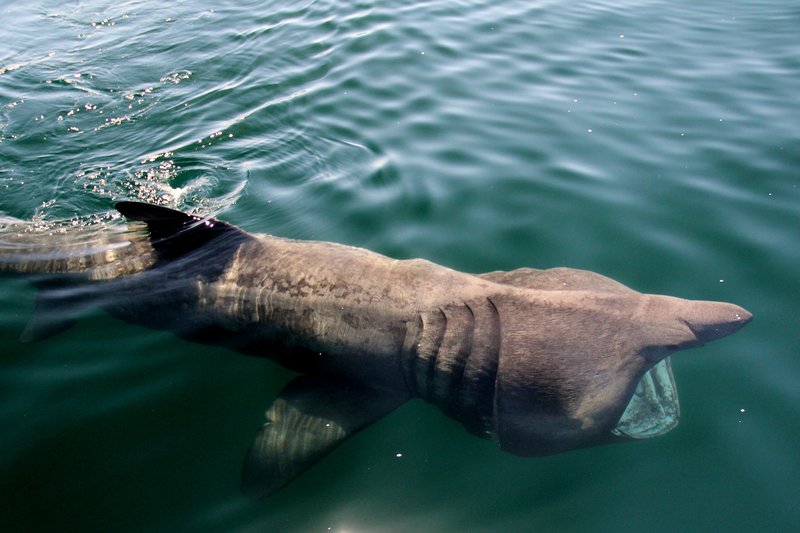Basking Shark aplenty in Dingle Bay, West kerry, Ireland S.W.
Basking Shark off the Blasket Islands

Basking Shark in Dingle Bay

Video
(8) Basking Shark Aplenty in Dingle Bay Co. Kerry 31st March 2018 Whale Watch Season
Like humpback whales, in our last log, basking shark are coming earlier to Irish waters in recent years. Whereas the earlier arrival and departure of humpback whales to Irish waters in recent years is almost certainly related to the availability of sand eels earlier in the season (which in turn is related to earlier plankton blooms) their earlier departure is almost certainly caused by man and related to the unregulated over fishing of their forage fish prey species - sprat and juvenile herring - in Irish Inshore Waters in Autumn.Previously, basking shark (Cetorhinus maximus) appeared in Irish waters at the start of the season when the surface sea water temperature was about 11 to 12 degrees Celsius usually around mid-April to end of May. The fact that they basked on the surface in the sunlight and often appeared at the start of summer (May) may be part of the reason why they were often incorrectly referred to as sun-fish*. Records show that up to 200 "sun-fish" were killed in one day in May 1815 off the Connemara coast, Co. Galway in the fishery there which was mainly for liver oil (squalene) as a 4 ton basking shark has a 1 ton liver (used for buoyancy) yielding approx. 14 barrels of liver oil.
We noticed that for the past couple of years they appeared when the surface water temperature was about 10 degrees Celsius and now for 2018 season on March 31st on our first Afternoon Eco Marine Tour of the season we have encountered many basking shark including some very large males, and females accompanied by (very) young when the surface sea water temperature is under 8 degrees Celsius which means that their favourite food the planktonic shrimp-like copepod Calanus helgolandicus is plentiful in the surface water.
A huge amount of mystery still surrounds the life history and ecology of the basking shark apart from their brief appearance at the start of summer, as interest wanes proportionally as they disappear from our shores 5 to 6 weeks after their first appearance. New research shows that they travel both horizontally ( 3,500 km.) and vertically ( 1,000 meters) in the water column and their diet includes deep water plankton as well as surface feeding on the zooplankton Calanus helgolandicus
The Beautiful Anatomy and Sensory Sophistication of Basking Shark
In the Irish Times of Saturday March 31st, Michael Viney quoted from the wonderful "Irish Beast Book" of J. Fairley and his appreciation of the long-tailed field mouse Apodemus - "There is something exceedingly attractive about Apodemus at rest - poised, alert, quivering".
Perhaps if J. Fairley were to reflect on the Basking Shark he might say something like - " They are beautiful, grotesque, mysterious, placid behemoths of the deep exemplifying all the attributes of specialisation and persistence to survive over millions of years (450 million) before man evolved a mere 2 million years ago or even before the dinosaurs evolved 250 million years ago. We can only gaze on them with wonder".
Basking shark are passive, planktivorous feeders which they do by swimming around with their mouths open filtering plankton from the water. As their favourite food Calanus helgolandicus is on average about half the size of an uncooked grain of rice they need a big mouth to gulp in sufficient quantities - but what a mouth!
The mouth gape is up to 6 ft. wide on bigger specimens (stretch your arms out and from fingertip to fingertip is about 6 ft. or 1 fathom). Their head is encased with 5 large gill slits and each of these gill slits contain thousands of little hook-like gill rakers for filtering out plankton. The outer "lips" of the mouth, which are tooth cartilage, have 6 rows of teeth on the upper jaw and 9 rows of teeth on the lower jaw, totalling over 1,500 small teeth which are not actually used for eating but for grasping mating partners!
In fact it is the thick mucous produced around the thousands of gill rakers - which flatten down when the mouth is closed every 60 seconds to gulp - that trap the plankton and the soupy mix is then squarmed down the throat by the 1 meter long tongue
But How do Basking Shark find their Prey in the Ocean Deep?
Basking sharks have two lethal weapons when it comes to finding their prey.
Firstly from an examination of sharks' brains it is apparent that the olfactory lobes take up almost 2/3 of the brain area, so interpretation of smell (olfaction) is very important to Basking Shark in locating prey. Their olfactory organs are constantly smelling the water and it is even surmised that they can smell / taste the Di-methyl sulphide (DMS) given off by phytoplankton when being grazed upon by zooplankton (Dr. Sims). Interestingly DMS is the "secret ingredient" added to the chum used on pelagic bird watching trips by skippers to attract seabirds, especially Wilson's petrels and storm petrels, as their olfactory senses are also highly developed and they can smell the chum with the added DMS from a distance of 3 to 4 miles when downwind.
But like other sharks their real and very sensitive lethal weapon is their nose! Sharks are able to detect and interpret electrical activity in the water from a great distance, even discriminating the electrical impulses made by their preferred prey species Calanus helgolandicus from other similar species, by the sensory mass of electrical detectors found above their nose called the Ampullae of Lorenzini.
These Ampullae of Lorenzini can also detect different salinity levels in the water and possibly detect different temperature clines and specific gravity variations in the sea water, so that to the basking shark, or any other shark including its direct relative the Great White Shark with whom it shares a common ancestor, the deep ocean is not an amorphous zone but it can detect the different stratifications in the water column and literally follow its nose along the chosen water stratum until it discerns the electrical impulses given out by its preferred prey.
Basking Shark and their prey Calanus helgolandicus as Indicators of Climate Change
As mentioned above the deep ocean is not an amorphous zone and consists of underwater mountains higher than Mount Everest, underwater canyons many times deeper than the Grand Canyon, huge underwater rivers that would dwarf the puny Amazon, raging underwater tides, gyres, and submergence and recirculation of surface ocean water in oceanic thermoclines that have life cycles of thousands of years before they re-emerge. There are fronts where warm and cold water collide, just as hot and cold air collide in our atmosphere causing our "weather", and these fronts and tidal zones are rich areas for plankton blooms and changes in plankton bloom occurrence, density and distribution parallel climatic fluctuations. The Basking Shark have evolved over 450 million years and having survived two mass extinctions including one which exterminated 99% of marine fauna in toxic coloured seas, have the sophisticated equipment to assess these fluctuations and changes as they pursue hordes of their prey Calanus helgolandicus relentlessly, and this in turn can give us indications of the factors influencing these plankton bloom fluctuations and changes which parallel climatic fluctuations and are directly related to heat, light, radiation and quality and quantity of nutrient sources available.
The sun-fish* is telling us something about our environment. It has the knowledge of 450 million years of evolution......Perhaps we should listen.
Log of the whale watching tour boat M.V. "Blasket Princess"
Captain Whales Galore 31.03.2018
[* Former common name in Ireland. The real Ocean sunfish (or moon fish in German) Mola mola is the largest bony fish in the world, whereas the Basking Shark is the second largest cartilaginous fish in the world after the whale shark]
















